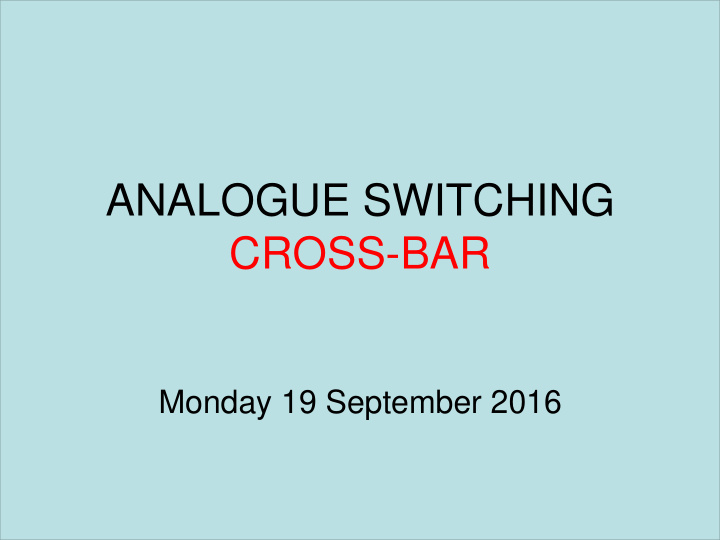



ANALOGUE SWITCHING CROSS-BAR Monday 19 September 2016
HISTORY OF CROSS-BAR EXCHANGES 1. 1915: Bell company Western Electric's "coordinate selector “ 2. 1919: Swedish governmental agency designs cross-bar based Gotthilf Betulander design. 3. 1938: AT&T's 1XB crossbar exchanges developed by Bell Telephone Labs.
GENERAL DEFINITION • A switch connecting multiple inputs to multiple outputs in a matrix manner. N-Inputs M-Inputs • Other Types of Switches: – Rotating Switch – Memory Switch
3X3 CROSSBAR SWITCH(1)
3X3 CROSSBAR SWITCH(2)
3X3 CROSSBAR SWITCH(3)
3X3 CROSSBAR SWITCH(4)
6X6 CROSSBAR SWITCH Activation Sequence: 1. Energize Horizontal Bar 2. Energize Vertical Bar 3. De-Energize Horizontal Bar
NON-BLOCKING X-BAR N Inputs N - Outputs A non-blocking cross-bar switch has the following parameters: a)Number of Switches - N 2 b)Number of Connections – N/2
COST -CAPACITY EUF Number of Switch (Capacity/Switc Subscribers Switches Capacity hes) 4 16 2 0.125 16 256 8 0.03125 64 4,096 32 0.0078125 128 16,384 64 0.00390625
DIAGONAL CONNECTION X-BAR(1)
DIAGONAL CONNECTION X-BAR(2) Number of Cross-points = N(N-1)/2 N SW-XBAR SW-DIAGONAL X-BAR 4 16 6 16 256 120 64 4,096 2,016 128 16,384 8,128
DOUBLE-SWING HORIZONTAL SWITCH BARS Double-Swing X-bars Vertical Hold X-bars
BLOCKING CROSS-BAR (1) R’ Q’ P’ P Q R A B SUBSCRIBERS (N) C D E F G
BLOCKING CROSS-BAR (2) K = 3 R’ Q’ P’ P Q R A SUBSCRIBERS (N) B C D E F G No. Switches = 2NK where: a)N = Number Subscriber b)K = Max No. of Connections
BLOCKING CROSS-BAR WITH TRANSFER LINES K=3 R’ Q’ P’ P Q R A B L= 2 C D E F G OGT1 No. Switches = N(2K+L ) where OGT 2 a)N = Number Subscriber b)K = Max No. of Local Connections c)L = Max No. of Outgoing Lines
CROSS-BAR EXCHANGE ORGANIZATION (2)
CROSS-BAR EXCHANGE ORGANIZATION (1) Dial Tone Marker Links DT REG1 - H Subscriber IOT 1 - M Lines ICT 1 - K 1 - N OGT 1 - L Secondary Switch Primary Switch Trunk Frame Establishment/Completing Marker
LOCAL SIGNALLING Sunday, September 25, 2016
TYPES OF SIGNALLING There are two types of signaling in telephone networks: 1.Local Loop signaling which includes: a)Exchange of dialed Numbers, b)Dial Tone, c)Ringing Current, d)Busy Tone, e)Number Unobtainable (NU) Tone; f)Synthesized voice announcements 2. Inter-exchange signaling, i.e passing of control information between different exchanges. 3. Intra-exchange i.e passing of information between different subsystems of a telephone exchange.
ORIGINS OF SIGNALLING: FIVE SIGNALLING FUNCTIONS BY OPERATOR Before the advent of automatic exchanges, human telephone operators performed the following signaling functions: 1.Respond to the calling subscriber to obtain the identification of the called party. 2.Inform the calling subscriber that the call is being established. 3.Ring the bell of the called party. 4.Inform the calling subscriber, if the called party is busy. 5.Inform the calling subscriber, if the called party line is not obtainable for some reason.
DIAL TONE 1. Indicates that the exchange is ready to accept dialled digits from the subscriber. 2. The subscriber should start dialling only after hearing the dial tone. 3. Else, initial dial pulses may be missed by the exchange which may result in the call landing on a wrong number or exchange timing out
BUSY TONE Busy tone is send to the dialler when the subscriber line is busy.
NUMBER UNOBTAINABLE Number un-obtainable is send to the dialler when the number he has dialled is not in the valid, i.e, disconnected or not registered.
ROUTING TONE OR CALL-IN-PROGRESS TONE 1. Some exchanges used to send this tine to the dialler when the call was in progress of being connected. 2. With increased speed of telephone exchanges. This feature has been discontinued.
RINGING TONE • As the ringing current is transmitted to the called subscribe, the control equipment sends out a ringing tone to the calling subscriber
REVIEW QUESTIONS • What are the disadvantages of in-channel signalling? • How are the traditional local-loop signalling functions implemented in GSM?
Recommend
More recommend